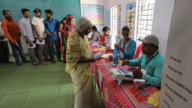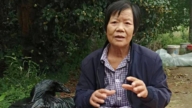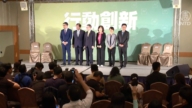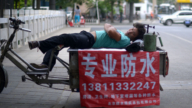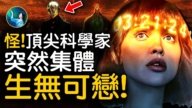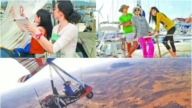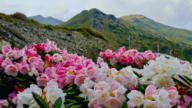【新唐人北京時間2022年01月12日訊】台灣原生牛樟木,是國寶級保育樹種。但仍有不肖業者,盜採運送到中國大陸繁殖。大陸更宣稱,牛樟芝是屬於中國大陸的。台灣國寶牛樟芝協會理事長陳水田認為,有義務為台灣牛樟木「證身」。藉由公司技術,為牛樟木鑑定,打造專屬的數據庫。
Cinnamomum kanehirae that is endemic to Taiwan is a national treasure-level protected plant species. However, there are still unethical businesses illegally harvesting and transporting them so that they can be grown in Mainland China. unethical businesses illegally collecting and transporting them so that they can be grown in Mainland China. Mainland China has even claimed that Antrodia cinnamomea belongs to them. Shui-Tein Chen, chairman of the Antrodia Cinnamomea Association of Taiwan National Treasure, believes that they are obliged to “authenticate” Cinnamomum kanehirae by using the company’s technology to create an exclusive database for the identification of Cinnamomum kanehirae.
台灣國寶牛樟芝協會理事長陳水田:「把牛樟真的是台灣的正本經營,把它講給全世界知道。」
Shui-Tein Chen, chairman of the Antrodia Cinnamomea Association of Taiwan National Treasure, said that “Antrodia cinnamomea really comes from Taiwan, and the world should know the truth.”
台灣國寶牛樟芝協會理事長陳水田表示,牛樟樹是台灣特有原始種。不過,中國宣稱牛樟芝是中國的。他舉例,2016年受邀參加中國福建牛樟芝研究所,舉辦的世界中草藥聯合會議,主辦方就把牛樟列為中國牛樟。陳水田認為,有義務為台灣牛樟木「證身」。
Shui-Tein Chen, chairman of the Antrodia Cinnamomea Association of Taiwan National Treasure, stated that the Antrodia Cinnamomea is a unique species that is endemic to Taiwan. However, Mainland China claims that the species comes from the Mainland. He provided an example where he was invited to participate in the World Chinese Herbal Medicine Conference organized by the Fujian Antrodia Cinnamomea Research Institute, and the organizer listed Antrodia cinnamomea as Chinese Antrodia cinnamomea. Chairman Chen believed that he is obliged to “authenticate” Cinnamomum kanehirae.
台灣國寶牛樟芝協會理事長陳水田:「這些所有的樹木,我們是不是可以把它做它的DNA的基原鑑定。列一個QR Code,將來的話就有一個數據庫。」
Shui-Tein Chen, chairman of the Antrodia Cinnamomea Association of Taiwan National Treasure, said that “There should be a way for us to conduct basic identification of the DNA for all of these plants and trees, give them QR codes and that should make it possible to create a database in the future.“
陳水田利用牛樟芝同位素含量比率,判別生長地。運用先進分析技術,進行產品成分及栽種基材鑑定。
Shui-Tein Chen believes that it is necessary to identify the age of thetree through the isotope of Cinnamomum kanehirae, the certification of the origin, and the use of advanced analysis techniques (isozyme analysis and PCR) for the identification of the planting substrate.
台灣國寶牛樟芝協會理事長陳水田:「今天如果他把它運到北京,或是他把它運到四川,這個很多都已經在那邊都在種了,我不認為那個是道地的藥材,因為它不是在適當的地方生長。」
Shui-Tein Chen, chairman of the Antrodia Cinnamomea Association of Taiwan National Treasure said that “When someone transports Antrodia cinnamomea to Beijing or to Sichuan, a lot of Antrodia cinnamomea is already being grown there. I don’t think that Antrodia cinnamomea is an authentic and local medicinal material since it isn’t growing in the appropriate place.”
台灣牛樟芝產值曾高達新台幣30億元。但2013年的牛樟芝有毒事件,儘管有關單位出面澄清,也挽回不了對產業的重創。陳水田表示,協會在風波後成立並每年辦研討會,共同探討台灣牛樟發展走向。
The output value of Antrodia cinnamomea in Taiwan was as high as NTD$3 billion. However, the incidence of toxic Antrodia cinnamomea in 2013 inflicted heavy damage to the industry even though the relevant units came forward to provide clarification. Shui-Tein Chen said that the Association was established after the incident and seminars were held annually to jointly discuss the development direction of Antrodia cinnamomea in Taiwan.
台灣國寶牛樟芝協會理事長陳水田:「要讓牛樟芝發揚光大,還是要做新藥開發,因為你一個新藥開發做出來的技術,你可以有20年的專利。另外一個想法,這個牛樟既然是木頭,然後有那麼漂亮的彩色顏色,是不是可以往文創的方向,來做這個展覽。」
Shui-Tein Chen, chairman of the Antrodia Cinnamomea Association of Taiwan National Treasure, said that “If Antrodia cinnamomea is to flourish and used to develop new drugs, there’s a 20-year patent because of the technology used to develop new drugs. Another concept is that since the Cinnamomum kanehirae is a wood that possesses such beautiful colors, perhaps it’s possible to create culture and creative exhibitions around them.”
2014年8月舉辦首次牛樟芝藝術展,獲得廣大迴響;2019年擴大舉辦牛樟芝文化節,展現牛樟芝軟實力。台灣業者研發腳步也不停歇。把牛樟菇萃取成粉狀,做複方基底,或是將牛樟木萃取精油,開發多元產品。也有業者,投入抗疫口服藥的研究開發。
The first Antrodia cinnamomea art exhibition was held in August 2014 and was a big hit. The art exhibition was expanded into the Antrodia Cinnamomea Cultural Festival in 2019 to exhibit the soft power of Antrodia cinnamomea as the R&D of Taiwanese businesses was in full force. They made a powder extract out of the Antrodia cinnamomea that was used as a compound base, extracted the oil from the Antrodia cinnamomea to develop a variety of products and some businesses even became involved in the research and development of COVID-19 Oral Antiviral drug candidate.
台灣國寶牛樟芝協會理事長陳水田:「在中研院的P3實驗室用Delta病毒。這個動物實驗在10月,已經通通做完了,那這個動物實驗的效果是,我們看起來是,非常非常的好。」
Shui-Tein Chen, chairman of the Antrodia Cinnamomea Association of Taiwan National Treasure, said that “The medication was being used experimentally against the Delta variant at the P3 Laboratory of the Academia Sinica and the results from the animal trials completed during October seem to be quite promising.”
陳水田也不忘企業社會責任,幫助罕見疾病病友。
Shui-Tein Chen also reremember fulfilling corporate social responsibility as he provides aid to patients with rare diseases.
台灣國寶牛樟芝協會理事長陳水田:「因為牛樟是台灣特有的,不是有錢人才可以吃得到的。在公司有這樣一個設定,希望說,譬如說老人年金他就吃得起。有需求的人可以提供給他。」
Shui-Tein Chen, chairman of the Antrodia Cinnamomea Association of Taiwan National Treasure, said that “Since Antrodia cinnamomea is endemic to Taiwan, it isn’t something that is accessible onlyby wealthy individuals. Our company hopes that the elderly can use their pensions to gain access to the Antrodia cinnamomea and those who need to consume Antrodia cinnamomea can also gain access to it.”
經協會與產官學研多年努力,台灣牛樟芝產業有復甦跡象。要攜手前進,擴展國際市場。
After years of hard work by the Association, the government, industry, universities and institutes, the Antrodia Cinnamomea industry in Taiwan has shown signs of rejuvenation as the entire industry must collaborate to expand the international market.
採訪撰稿:李晶晶
攝影後製:陳輝模
Interview and writing by Jin-Jin Li
Photography post production: Hui-mo Chen






